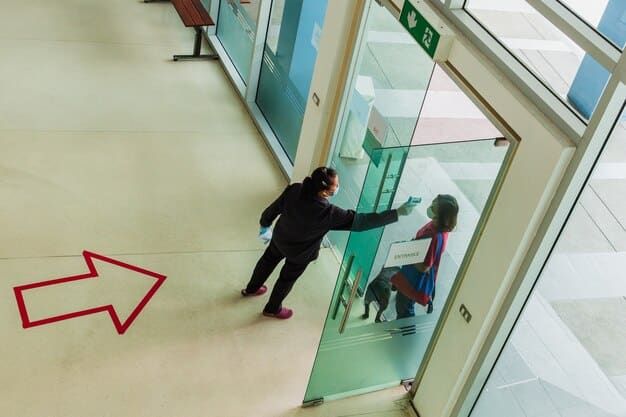Career Crossroads: Lateral Moves in 2025 – Your Definitive Guide

A lateral career move in 2025 involves shifting roles or departments without a direct promotion, often driven by a desire for new skills, industry change, or enhanced work-life balance rather than just a pay raise, requiring careful strategic planning and self-assessment for successful implementation.
In the dynamic landscape of the modern workforce, career paths are rarely linear. For many professionals, discerning the next step can feel like standing at a crucial juncture, a veritable Career Crossroads: Is a Lateral Move the Right Choice for You in 2025? This question resonates deeply as individuals seek not just upward mobility, but also greater fulfillment, skill diversification, and a better alignment with their personal and professional aspirations.
Understanding the Lateral Move: Beyond the Traditional Ascent
A lateral career move signifies a shift in your professional trajectory that doesn’t necessarily involve a promotion or a significant increase in salary. Unlike the traditional view of career progression as a straight climb up the corporate ladder, a lateral move often involves transitioning to a role at a similar level within a different department, team, or even a new industry entirely. This strategic sidestep can be incredibly valuable, offering opportunities for skill diversification, exposure to new challenges, and a fresh perspective on your career path.
In 2025, the concept of a “successful” career is evolving beyond mere title and compensation. Professionals are increasingly valuing autonomy, work-life integration, and the acquisition of future-proof skills. A lateral move, when executed thoughtfully, can serve as a powerful tool to achieve these evolving objectives, providing a foundation for long-term growth that might not be immediately apparent in a conventional upward promotion.
Why Consider a Lateral Move? Unpacking the Motivations
The reasons for pursuing a lateral move are diverse and deeply personal, extending far beyond the superficial. It’s often a calculated decision stemming from a desire for growth, albeit in a different dimension than vertical ascent. Understanding these core motivations is crucial for determining if this path aligns with your aspirations.
- Skill Acquisition and Diversification: Many professionals pursue lateral moves to gain new competencies or to deepen existing skills in a different context. This can be invaluable in a rapidly changing job market where versatility is key.
- Industry or Role Exploration: A lateral shift allows for exploration of different industries or functional roles without starting from scratch. It’s a lower-risk way to test the waters and discover new passions.
- Work-Life Balance Improvement: Sometimes, a lateral move can offer a better work-life balance, perhaps through reduced travel, more flexible hours, or a less demanding team culture, even if the salary remains the same.
Ultimately, a lateral move is a proactive choice to steer your career in a direction that aligns more closely with your personal values and long-term professional goals, moving beyond the traditional metrics of success like promotions and salary bumps. It’s about strategic positioning for future opportunities and enhanced job satisfaction.
Assessing Your Readiness: The Self-Reflection Imperative
Before embarking on any significant career change, particularly a lateral move, a thorough period of self-reflection is not just recommended, but essential. This internal audit helps clarify your motivations, assess your current capabilities, and identify potential risks and rewards. Without this foundational understanding, your lateral move could lack direction and fail to yield the desired outcomes. It’s about aligning your deepest professional desires with actionable steps.
Understanding your “why” is paramount. Are you seeking new challenges, escaping a toxic environment, or genuinely passionate about a different area of work? Your clarity on these points will guide your decision-making process and ensure that the move serves a meaningful purpose in your career narrative. This is not a time for impulsive decisions, but for deliberate, introspective analysis.
Key Questions for Deeper Insight
To facilitate this self-assessment, consider a series of probing questions designed to uncover your true objectives and evaluate your current professional standing. These questions help build a comprehensive picture of your readiness.
- What are your intrinsic motivations for considering a lateral move? Is it genuine curiosity, burnout in your current role, or a strategic play for future opportunities?
- What skills do you possess that are transferable to a new role or industry? Identify your strengths and how they might be recontextualized.
- What skills do you need to acquire to succeed in your desired lateral role? Pinpoint skill gaps and plan for their development.
Additionally, evaluate your comfort with uncertainty. Lateral moves often involve a degree of ambiguity, as the outcomes aren’t always immediately clear. Your ability to adapt and thrive in less defined situations will play a significant role in the success of your transition. This period of intense self-reflection forms the bedrock of a successful lateral career move, ensuring your decision is well-founded and strategically sound.
Strategic Planning for a Lateral Shift: Mapping Your Course
Once you’ve deeply understood your motivations and assessed your readiness, the next crucial step is developing a robust strategic plan. A lateral move, by its nature, is a deliberate rather than reactive decision, and without a clear roadmap, you risk aimlessness. This planning phase transforms your aspirations into actionable steps, guiding your transition with purpose and precision. It involves meticulous research, networking, and skill development, all tailored to your specific lateral objective.
Your strategy should encompass not just the ‘what’ and ‘why,’ but also the ‘how’ and ‘when.’ Consider the various internal and external avenues available for a lateral shift, and think about how your current position can be leveraged to facilitate the transition. This includes identifying key stakeholders, both within and outside your current organization, who can offer guidance or open doors. The emphasis here is on proactive preparation, mitigating potential pitfalls and maximizing opportunities.
Crafting Your Action Plan
A well-defined action plan breaks down the daunting task of a career change into manageable steps. This detailed approach ensures that every effort is purposeful and contributes to your overarching goal. It’s about setting realistic expectations and milestones.
- Identify Target Roles and Companies: Research specific roles and organizations that align with your lateral objectives. Look beyond job titles to understand the actual responsibilities and corporate culture.
- Network Strategically: Connect with professionals in your target roles or industries. Informational interviews can provide invaluable insights and potential leads, often more so than formal applications alone.
- Upskill and Reskill: Address any identified skill gaps through online courses, certifications, or volunteer work. Demonstrating initiative in acquiring new competencies reinforces your commitment and readiness.
Furthermore, prepare for potential resistance or skepticism, especially if your lateral move seems unconventional to others. Articulating your vision and the strategic benefits of your shift will be vital. By meticulously planning and preparing, you transform a theoretical desire into a tangible, achievable outcome, setting the foundation for a successful lateral career journey in 2025.
Navigating Internal vs. External Opportunities
When considering a lateral move in 2025, a critical decision point is whether to pursue opportunities within your current organization or to look externally. Both paths offer distinct advantages and challenges, and the optimal choice often depends on your specific goals, the culture of your current workplace, and the broader market landscape. Each route requires a tailored approach and a clear understanding of the nuances involved.
An internal lateral move can leverage existing relationships and institutional knowledge, potentially making the transition smoother. You already understand the company’s dynamics, and your reputation is established. However, external lateral moves can offer a complete fresh start, new organizational cultures, and exposure to different industry practices, which might be necessary if your current company doesn’t offer the desired pathways or skill development opportunities. Weighing these factors carefully is crucial for a strategic decision.

Internal Lateral Moves: Leveraging Your Current Standing
Pursuing a lateral move within your existing company can be an effective strategy if your organization supports internal mobility and development. This approach benefits from your established credibility and network.
- Advantages:
- Known Quantity: Your performance history and work ethic are already established, reducing the hiring risk for the company.
- Existing Network: You can leverage internal connections for insights, mentorship, and advocacy.
- Smoother Transition: Familiarity with company culture, systems, and procedures can make onboarding easier.
- Considerations:
- Limited Options: The range of available lateral roles might be restricted by the company’s size or structure.
- Perception Management: You might need to actively reshape perceptions among colleagues or management who view you only in your current role.
- Salary Plateau: Internal moves, especially lateral ones, might not always come with significant salary adjustments.
External Lateral Moves: Embracing New Horizons
Looking outside your current organization for a lateral move opens up a broader spectrum of possibilities, offering a chance to truly reinvent your professional identity or dive into entirely new fields.
- Advantages:
- Fresh Start: Opportunity to leave behind old perceptions and establish a new professional brand.
- Broader Scope: Access to a wider array of industries, company cultures, and role types.
- Potential for New Challenges: Exposure to different business problems and approaches can accelerate learning and growth.
- Considerations:
- Higher Risk: You are an unknown entity, requiring more effort to prove your capabilities and fit during the application process.
- Severing Ties: You might lose benefits, tenure, or a comfortable network built over time.
- Cultural Adjustment: Adapting to an entirely new company culture can be challenging and take time.
The decision between internal and external should be driven by a clear understanding of your career aspirations for 2025. If deep specialization and internal growth are priorities, staying put might be sensible. If broad exposure, significant skill shifts, or a complete change of environment are desired, an external move typically offers more avenues. Regardless of the path chosen, strategic networking and clear articulation of your transferable skills are paramount to success.
Crafting Your Narrative: Communicating Your Value
Perhaps one of the most challenging aspects of a lateral move is articulating its rationale. When you’re not moving “up,” some might question the wisdom of your decision. This is where a compelling narrative becomes your most powerful tool. You need to confidently explain why this sidestep is, in fact, a forward motion for your career, demonstrating foresight and strategic thinking rather than perceived stagnation or regression. Your ability to communicate this vision is crucial for gaining buy-in from future employers, and potentially, your current one.
Your resume, cover letter, and interview responses must be meticulously crafted to highlight how your past experiences, even if seemingly unrelated, have equipped you with transferable skills and a unique perspective. This isn’t about downplaying your previous roles, but about reframing them through the lens of your desired lateral position. Emphasize the long-term benefits and your commitment to continuous learning and adaptation, positioning yourself as a versatile asset ready for new challenges.
Tailoring Your Communication for Impact
Every communication point – from initial outreach to final interviews – must reinforce your lateral move’s strategic intent. This requires precision and a clear, consistent message.
- Resume and Cover Letter:
- Highlight Transferable Skills: Focus on competencies like project management, problem-solving, communication, and adaptability, which are valuable across various roles and industries.
- Quantify Achievements: Use metrics and data to demonstrate the impact of your past work, even if the context is different.
- Craft a Compelling Summary/Objective: Clearly state your interest in a lateral move and the value you bring to the target role, emphasizing growth in new dimensions.
- Interview Preparation:
- Articulate Your ‘Why’: Be ready to explain your motivations for a lateral move confidently and concisely, linking it to your long-term career vision.
- Showcase Enthusiasm for Learning: Express genuine excitement about acquiring new skills and adapting to unfamiliar challenges.
- Address Perceived Gaps Proactively: Anticipate questions about your lack of direct experience in the new domain and discuss how your existing skills and learning agility compensate for it.
Successfully navigating a lateral move requires not just technical prowess but also persuasive communication skills. By mastering the art of storytelling around your career choices, you can transform a non-traditional path into a compelling demonstration of your strategic foresight and adaptability, significantly increasing your chances of securing the desired role in 2025.
Common Pitfalls and How to Avoid Them
While a lateral move can be an incredibly rewarding strategic choice, it is not without its potential pitfalls. Being aware of these common traps allows for proactive mitigation, safeguarding your transition and ensuring the move genuinely serves your long-term career objectives. Rushing the process or failing to deeply assess the implications can lead to regret and set back your professional journey. It’s about being prepared for the unforeseen and making informed decisions at every turn.
One primary mistake is underestimating the learning curve in a new role or industry. Even if the professional level remains similar, the context, terminology, and key performance indicators can be vastly different. Another pitfall is failing to articulate the value of your existing experience to the new role, leading potential employers to see a misfit rather than a strategic pivot. A thorough understanding of these challenges is the first step toward a well-executed lateral transition.

Avoiding Common Missteps
Strategic foresight and diligent preparation are your best defenses against the obstacles commonly encountered during a lateral shift. Anticipating these issues allows you to build resilience and develop contingency plans.
- Lack of Clear Objectives:
- Pitfall: Making a lateral move without a well-defined reason, leading to disillusionment or another short-term job hop.
- Solution: Conduct a comprehensive self-assessment to clarify your motivations (e.g., skill acquisition, better work-life balance, new industry exploration). Define what success looks like in your new role beyond just getting the job.
- Underestimating the Transition Period:
- Pitfall: Expecting immediate success or comfort in a new role, department, or industry, leading to frustration.
- Solution: Be mentally prepared for a learning curve. Give yourself at least 6-12 months to fully adapt, contribute meaningfully, and feel truly settled. Seek out mentors and resources in your new domain.
- Poor Communication of Value:
- Pitfall: Failing to effectively communicate how your existing skills and experiences transfer to the new lateral role, or why this move is strategic for you.
- Solution: Practice articulating your compelling narrative. Translate your past achievements into the language of the new role,
emphasizing transferable skills and your eagerness to learn and grow in the new context.
- Ignoring Financial Implications:
- Pitfall: Overlooking potential salary stagnation or even a temporary pay cut, leading to financial strain or resentment.
- Solution: Thoroughly assess the financial impact of the move. If a salary decrease is involved, ensure your long-term goals (e.g., skill development, work-life balance) genuinely outweigh the financial trade-off. Have a financial buffer.
- Neglecting Networking:
- Pitfall: Attempting a lateral move in isolation, missing out on crucial insights and opportunities.
- Solution: Proactively network with individuals in your target roles and industries. Informational interviews provide invaluable context, potential connections, and direct insights into the reality of the work.
By carefully considering and proactively addressing these common pitfalls, you can significantly enhance your chances of a successful and fulfilling lateral career move in 2025. It’s about thoughtful execution driven by a clear vision, ensuring that your sidestep is indeed a strategic step forward.
Measuring Success and Futureproofing Your Career
Once you’ve made a lateral move, the journey isn’t over. Defining success in this new context may differ from traditional career metrics. It’s not just about what you achieve, but how you grow, adapting to the nuances of your new role and environment. Measuring this success goes beyond a new job title; it encompasses skill acquisition, enhanced job satisfaction, and a clearer alignment with your long-term professional vision. This ongoing evaluation ensures your lateral move truly serves its intended purpose and positions you for future growth.
Furthermore, a well-executed lateral move can be a powerful tool for futureproofing your career. By diversifying your skillset and gaining exposure to different areas, you become a more versatile and resilient professional, better equipped to navigate the ever-evolving job market. This proactive approach to career development is paramount in 2025, where continuous learning and adaptability are not just buzzwords, but necessities for sustained relevance and advancement.
Redefining Success Post-Lateral Move
Success after a lateral move is a multifaceted concept, transcending simple salary gains or promotions. It’s about personal and professional enrichment, aligning with your initial motivations.
- Skill Mastery: Successfully acquiring and applying new skills within your new role.
- Enhanced Job Satisfaction: Feeling more engaged, challenged, and fulfilled by your work than in your previous role.
- Network Expansion: Building meaningful relationships in your new department or industry.
- Clarity of Purpose: Gaining a clearer understanding of your long-term career aspirations and confirming your path.
- Problem-Solving Contribution: Effectively applying your diverse experiences to solve new problems and contribute uniquely to your team or organization.
Regularly check in with yourself. Are you achieving the growth you sought? Are you happier and more engaged? These qualitative measures are as important as any quantitative ones. Your lateral move should be seen as a stepping stone, providing a richer foundation for whatever comes next, preparing you for the fluidity of the future job market. By consistently evaluating your progress and seeking out new learning opportunities, you can ensure your lateral move continues to pay dividends for years to come.
| Key Point | Brief Description |
|---|---|
| 🔄 Strategic Shift | A lateral move is a deliberate pivot for new skills or balance, not just a promotion. |
| 🧐 Self-Assessment | Crucial for understanding motivations, identifying skills, and gauging readiness. |
| 🗺️ Action Plan | Detailed strategy involving target roles, networking, and skill development. |
| 🗣️ Narrative Crafting | Communicate your value by highlighting transferable skills and long-term vision. |
Frequently Asked Questions about Lateral Career Moves
A lateral career move involves transitioning to a role at a similar professional level, often without a direct promotion or significant pay increase. It’s typically driven by a desire to gain new skills, explore different areas within an organization, or improve work-life balance, rather than simply climbing the corporate ladder. This type of move prioritizes skill diversification and personal growth over immediate vertical advancement.
Consider a lateral move if your current role lacks growth opportunities, you desire to learn new, valuable skills, or you seek better work-life balance. It’s also suitable if you want to explore different industries or functions without starting from scratch. Self-reflection on your long-term career goals and priorities, beyond just compensation, is crucial for this decision.
The main benefits include gaining diversified skills, making your professional profile more robust and adaptable. It allows for exploration of different career paths or industries with less risk than a complete career change. It can also lead to improved job satisfaction through better alignment with personal values, enhanced work-life balance, and renewed professional engagement by escaping stagnation.
Frame your lateral move as a strategic decision for growth and skill expansion, not a step back. Highlight the transferable skills you gained and your clear objectives for the new role. Emphasize your proactive approach to career development, your eagerness to learn new things, and how this move aligns with your long-term aspirations, making you a more versatile asset.
Yes, while some lateral moves maintain salary, others might involve a temporary decrease, especially if you’re entering an entirely new field requiring new skills. It’s essential to assess your financial stability and prepare for any potential shifts in income. Consider the long-term return on investment in terms of skill acquisition and future earning potential rather than just immediate compensation.
Conclusion: Your Strategic Step Forward
Navigating a career crossroads in 2025 and opting for a lateral move can be a profoundly strategic decision, provided it’s approached with careful self-assessment, robust planning, and clear communication. It’s a testament to the evolving nature of professional success, which increasingly values skill diversification, personal fulfillment, and strategic positioning over a singular focus on vertical ascent. By embracing this approach, you’re not merely changing roles; you’re actively shaping a more resilient, satisfying, and future-proof career path. The true value of a lateral move lies in its capacity to unlock new avenues for growth and align your professional life more closely with your deepest aspirations.





